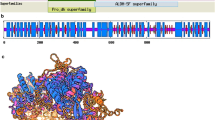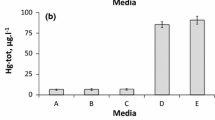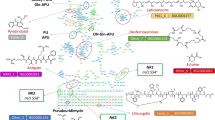Abstract
Dl-2,3,4,5,6-pentafluoromandelic acid (PFM) specifically inhibits the growth of Pseudomonas putida (ATCC 12633) on medium containing mandelate as sole carbon and energy source by competitive inhibition of mandelate dehydrogenase. PFM is not metabolized and is neither an inducer of the mandelate catabolic enzymes nor an antagonist of induction. Mutants resistant to the inhibitory effects of PFM (PFMr) were isolated; most prove to be superinducible, i.e. synthesize coordinately the mandelatespecific catabolic enzymes at elevated levels following induction. In at least one case the PFMr mutation maps very near the structural genes that encode the enzymes functional in the first two steps of mandelate catabolism. It is reasoned that the PFMr mutation is of the promotor type. Resistance to substrate analogs such as PFM offers a general method for isolation of regulatory mutants in catabolic metabolism.
Similar content being viewed by others

References
Bertrand, K., Korn, L., Lee, F., Platt, T., Squires, C. L., Squires, C., Yanofsky, C.: New features of the regulation of the tryptophan operon. Science 189, 22–26 (1975)
Bray, G. A.: A simple, efficient liquid scintillation fluid for counting aqueous solutions in a liquid scintillation counter. Analyt. Biochem. 1, 279–285 (1960)
Chakrabarty, A. M., Gunsalus, C. F., Gunsalus, I. C.: Transduction and clustering of genes in fluorescent pseudomonads. Proc. nat. Acad. Sci. (Wash.) 60, 168–175 (1968)
Chakrabarty, A. M., Gunsalus, I. C.: Defective phage and chromosome mobilization in Pseudomonas putida. Proc. nat. Acad. Sci. (Wash.) 64, 1217–1223 (1969)
Cook, A. M., Fewson, C. A.: Evidence for specific transport mechanisms for aromatic compounds in bacterium NCIB 8250. Biochim. biophys. Acta (Amst.) 290, 384–388 (1972)
Fieser, L., Fieser, M.: Experiments in organic chemistry, Boston: D. C. Heath and Co. 1957
Fowden, L., Lewis, D., Tristam, H.: Toxic amino acids: their action as antimetabolites. Advanc. Enzymol. 29, 89–163 (1967)
Gunsahis, C. F., Stanier, R. Y., Gunsalus, I. C.: The enzymatic conversion of mandelic acid to benzoic acid. III. Fractionation and properties of the soluble enzymes. J. Bact. 66, 548–553 (1953)
Hegeman, G. D.: Synthesis of the enzymes of the mandelate pathway by Pseudomonas putida. I. Synthesis of enzymes by the wild type. J. Bact. 91, 1140–1154 (1966a)
Hegenan, G. D.: Synthesis of the enzymes of the mandelate pathway by Pseudomonas putida. II. Isolation and properties of blocked mutants. J. Bact. 91, 1155–1160 (1966b)
Hegeman, G. D.: Synthesis of the enzymes of the mandelate pathway by Pseudomonas putida. III. Isolation and properties of constitutive mutants. J. Bact. 91, 1161–1167 (1966c)
Higgins, S. J., Mandelstam, J.: Evidence for induced synthesis of an active transport factor for mandelate in Pseudomonas putida. Biochem. J. 126, 917–922 (1972)
Rasai, T.: Regulation of the expression of the histidine operon in Salmonella typhimurium. Nature (Lond.) 249, 523–527 (1974)
Kenyon, G. L., Hegeman, G. D.: Mandelic acid racemase from Pseudomonas putida. Evidence favoring a carbanion intermediate in the mechanism of action. Biochemistry 9, 4036–4042 (1970)
Linnemeier, G. C.: Genetic and biochemical analysis of the histidine biosynthetic pathway in Pseudomonas putida. Thesis, Indiana University (1976)
Ornston, L. N.: Regulation of catabolic pathways in Pseudomonas. Bact. Rev. 35, 87–116 (1971)
Sargent, J. W., Seffl, R. J.: Properties of perfluorinated liquids. Fed. Proc. 29, 1699–1703 (1970)
Scaife, J., Beckwith, J. R.: Mutational alteration of maximal level of Lac operon expression. Cold Spr. Harb. Symp. quant. Biol. 31, 403–408 (1966)
Smyth, P. F., Clarke, P. H.: Catabolite repression of Pseudomonas aeruginosa amidase: isolation of promotor mutants. J. Gen. Microbiol. 90, 91–99 (1975)
Wheelis, M. L., Stanier, R. Y.: The genetic control of dissimilatory pathways in Pseudomonas putida. Genetics 66, 245–266 (1970)
Author information
Authors and Affiliations
Additional information
Dedicated to Prof. Roger Y. Stanier on the occasion of his 60th birthday
Rights and permissions
About this article
Cite this article
Hegeman, G.D., Root, R.T. The effect of a non-metabolizable analog on mandelate catabolism in Pseudomonas putida . Arch. Microbiol. 110, 19–25 (1976). https://doi.org/10.1007/BF00416964
Received:
Issue Date:
DOI: https://doi.org/10.1007/BF00416964



